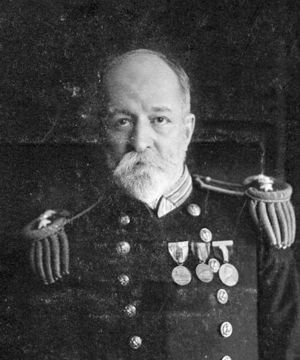
RAdm. George A. Converse.
Converse was born at Norwich, Vermont on 13 May 1844, the son of Shubael and Luvia Morrill Converse. From 1858–1861, he attended Norwich University, where he obtained a B.S. degree in 1863. In 1861, he was appointed midshipman and attended the United States Naval Academy, then at Goat Island, Newport, Rhode Island, from which he was graduated in 1865. He was commissioned an ensign on 1 December 1866 and in 1871 married Laura Shelby, with whom he had four daughters.
From 1865–1869, Converse was posted to the European squadron and served in the steam sloops Canandaigua and Frolic. There followed a brief tour with the Bureau of Navigation in 1869. From 1869–1872, he was posted to the Naval Torpedo Station at Newport, which had taken over the Goat Island facility. From 1872–1875, he was assigned to the staff of RAdm. Thornton A. Jenkins, commander of the Asiatic Fleet.
From 1875–1878, Converse returned to the Torpedo Station as an instructor. In 1876, he was instrumental in obtaining Lightning (Steam Launch No. 6), a spar torpedo boat designed by Nathaniel G. Herreshoff in nearby Bristol.
Until 1879, Converse served as executive officer of Marion. In 1883–1884 he served in Lancaster under RAdm. Charles H. Baldwin. After a tour with the Bureau of Ordnance, he returned to Newport for another tour as an instructor at the Torpedo Station in 1885 and served as inspector of torpedo boats during the construction of Cushing (Torpedo Boat No. 1) at Herreshoffs (1889–1890). There followed a sea tour in command of Enterprise (1890–1891) and another tour with the Bureau of Ordnance (1891–1892) before he returned to Newport to command the Torpedo Station as Inspector in Charge (1893–1897).
During the Spanish American War (1898), Capt. Converse commanded Montgomery in RAdm. William T. Sampson ’s squadron off Cuba. Postwar, he completed a tour with the Bureau of Navigation (1899–1901) and served on several naval boards. After his final sea tour in command of the battleship Illinois (1901–1903), he was promoted to rear admiral (21 October 1903) and served in turn as Chief of the Bureaus of Equipment, Ordnance and Navigation.
In 1904, when only the first sixteen “torpedo boat destroyers” were in commission, President Theodore Roosevelt ordered the Navy to convene a board under his leadership to “consider the types and qualities of torpedo vessels and their machinery.” The board developed a functional description for future destroyers, elements of which were first incorporated in the design of the Smith- and Paulding-class “flivvers” of fiscal years 1907–11.
RAdm. Converse retired in 1907 and died at Washington, D.C. on 29 March 1909. He is buried at Arlington National Cemetery.
Sources: Degolyer Library, Southern Methodist University, Arlington National Cemetery, Naval History & Heritage Command, Bauer and Roberts, Friedman.